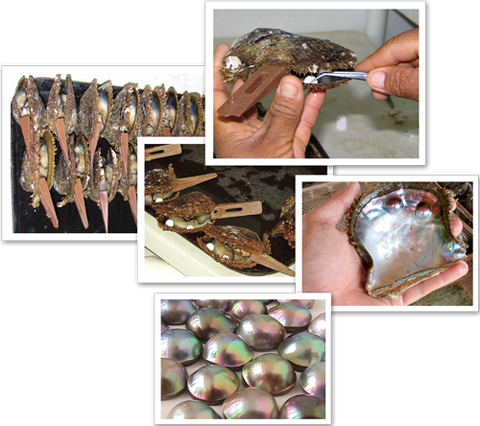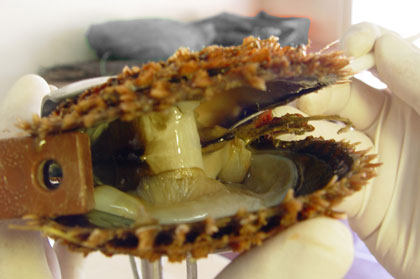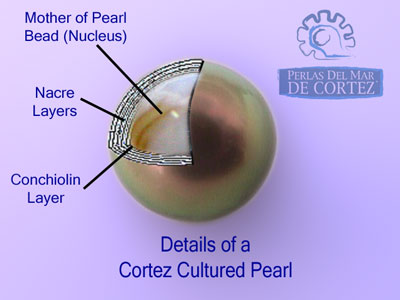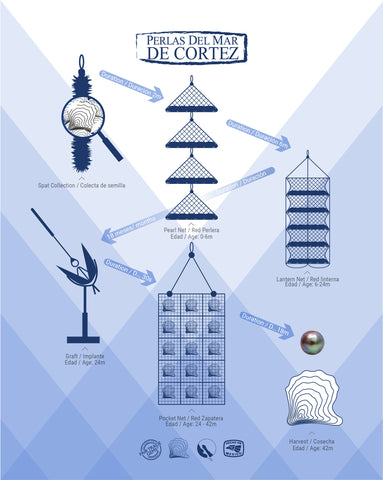The young adult oysters are taken out of their cages and scrubbed clean (they have a whole array of marine life growing on their shells: algae, sponges, barnacles, ascidians, etc.), then placed unto plastic trays and taken to the "Pearl Lab", where the operation will take place.
In most pearl producing countries, pearl oysters are forced to open by means of steel pliers, which may cause some mortality (from 40 to 70%, depending on the species used) in the oysters. You require the oyster to open up, in order for you to perform the "pearl seeding" operation. At our farm we do not force the oysters to open...they just open up for us.

With the live oyster's shell open, the operation can finally take place. We can perform two different kinds of procedures to make two different kinds of pearls: mabe pearls (also known as "Half-Pearls") and loose cultured pearls (symmetrical, baroque and Keshi).
Mabe Implant
To grow a mabe pearl, minor surgery is performed on the organism: You carefully expose the mother-of-pearl shell (found under the mantle tissue) by means of a spatula, then you glue the mabe implant (usually made of plastic) to the shell, the animal is returned to its watery home and then you wait some 14 to 23 months.
In this operation, one mimics the action of a "parasite" drilling through the shell, so the oyster is actually fooled into believing an intruder is inside. Thus, the oyster's mantle will cover the implant and then, slowly coat it up with layers of nacre.

The "Pearl Seeding" (or "Pearl Grafting") Operation
To obtain a loose cultured pearl, the operation involved is much more delicate. You place an oyster onto a special surgical stand, then you insert a small wedge between its shells (because the stand clamps it down), and then you visually find the oyster's reproductive organ and you make an incision in it, finally driving a special tool inside of it.
This tool is like a probe, long and thin and with the tip of a spear; it's used to make a long tunnel through the insides of the pearl oyster. You have to be very careful to avoid every one of the oyster's delicate organs: heart, pancreas and liver, stomach and gut. At the end of this tunnel, we localize a small, sack-like organ, called "the pearl sac". This organ has no real function, and it's made up of connective and gonadal tissues, making it the right choice for growing a pearl.
Next, a small bead -commonly known as the nucleus (made from the shell of a Mississippi mussel shell)- is introduced and led through the tunnel and into the pearl sac. Is it all over now? Not yet. You still need an extra ingredient: mantle tissue cells. To get the cells from the mantle into the pearl sac, you have to perform a "graft tissue operation".

This operation consists of first getting a suitable donor oyster (much like expecting someone to donate a much-needed kidney) to strip it off its mantle tissue. This long piece of tissue is then cut into smaller little pieces that we call "grafts", and finally they are put inside the oyster, just on top of the nucleus. If everything goes well, the oyster will survive, heal up, and pearl formation will start.
What is happening inside the Pearl Oyster?
Within the pearl oyster's soft tissues, a complex process is taking place: the little piece of mantle tissue, "grafts" itself into the surrounding tissues of the pearl sac, then it identifies the shell bead as mother-of-pearl shell and grows around it, covering entirely with nacre-secreting cells.

What follows now is the slow deposition of nacre around the bead. After two full years in culture, an oyster will coat the nucleus with millions of microscopic layers of nacre, and attain a thickness between 1.2 to 2.0 mm (sometimes even up to 3.0 mm!), which makes our Sea of Cortez Pearls as good as any South Sea Pearl.
The Pearl Harvest
The pearl oysters have stayed comfortably inside special culture cages known as "Pocket Nets". These are just like Condominiums to the pearl oysters: they have plenty of room for themselves, a nice view of the bay and all the food and nutrients they need. This way we are assured that our oysters grow fast and healthy. This is very important since healthy oysters living in a healthy environment will produce beautiful pearls.

Pearl harvest takes place within a year and a half (18 months) or over two years (32 months) after the organism was subjected to the pearl grafting operation. The harvest is performed in springtime when the waters of the Gulf of California are just starting to warm up after the cold winter.
The oysters are brought to the dock, cleaned and harvested. From each oyster we obtain many products: loose pearls, mabe, mother-of-pearl shell (to make buttons or sell as souvenirs), as well as a few natural pearls, and also a tasty meat product known locally as "callo" that you may call a "scallop". As you can see, nothing ever goes to waste.


